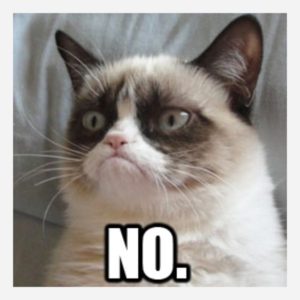OK, let’s talk memes.
Raise your hand if you saw the Bernie Sanders meme all over the internet. I can’t actually see you, but I know in my heart that your hand is held high. Trust me, mine is, too.
Now raise your hand if you actually used the meme on your social channels. Maybe you didn’t actually use the meme, but you tried to formulate a way in your mind to use it and nothing quite fit. Or, maybe you contemplated if this meme was fitting for your business or brand. Or perhaps you’re one of the last few standing arriving to this blog saying, “What in tarnation is a meme?”
No matter where you stand with memes, you’ve come to the right place. Because we’re going to talk about how to use them, when to use them, when NOT to use them, and how to know which memes (if any) are right for you.
Meme, language of origin
Believe it or not, the word “meme” is in the Miriam Webster dictionary. Don’t believe me? Go dust off the dictionary you inevitably have on hand and see for yourself! The definitions provided are, “1 : an idea, behavior, style, or usage that spreads from person to person within a culture,” and, “2 : an amusing or interesting item (such as a captioned picture or video) or genre of items that is spread widely online, especially through social media.”
Meme culture festers in digital landscapes, specifically social channels with posting/sharing capabilities, and they move at the speed of light. There are memes that, at this point, feel like old friends: like Grumpy Cat, or Bad Luck Brian, or Kermit drinking Lipton.



The most effective memes have a comedic photo, and some sort of accompanying templated phrase tied to it. The power of memes is that they are extremely relatable, and thus sharable. And if the stock version of a meme isn’t relatable to you, many sites equip users with the power to customize the message to fit any audience or topic.
What do you meme?
The staying power of these icons is strong and lasting, and memes are easily adaptable by brands. But how do you know what to meme? The primary criteria for whether or not you should use a meme is a critical evaluation of alignment with your brand’s voice, values, and tone.
When Done Right…
Memes can help your brand because of their wide appeal. The reason memes become popular is because they express a sentiment that many identify with, and the initial virality means you don’t have to do that heavy lifting. When done correctly, aligned with your brand voice, and integrated into your social strategy, memes can make your brand:
- Personable
- Humanized
- Relatable
- Authentic
When Done Wrong…
While memes can help you, they can also hurt your brand if used incorrectly. The content of a meme can insinuate a political leaning, or might just blatantly oppose your brand voice or who your brand is. A bad meme can translate as:
- Inauthentic
- Forced
- Confusing
- Offensive
So, before you put an unimpressed, masked Bernie on your company’s next social post, ask yourself: Have we posted anything fun, lighthearted, or with a comedic lean? Would this translate to our audience, or would it go over their heads? What subliminal message could this be sending?
Meme-ing with Meaning
Memes are curated for success in the scrolling age. Pair an image that’s burned into digital users’ brains with the prospect of a new, funny, bite-sized message and you have an almost perfect piece of content. So, how do you integrate memes into your content?
1. Social listen. Stay on the cultural hubs for memes, including Twitter, Tik Tok, and Reddit to see what memes are popular.
2. Move quickly. Memes have a shorter lifespan than a common housefly, so you’ll need to ride the wave of virality while it’s fresh.
3. Choose a caption that your followers will specifically relate to, and that fits within the established meme “template.”
So, content creators, step into the digital landscape with a diminished fear of memes. While mystical and, at times confusing, understanding meme culture can give you easy content curation, second-hand virality, and boost your brand.
